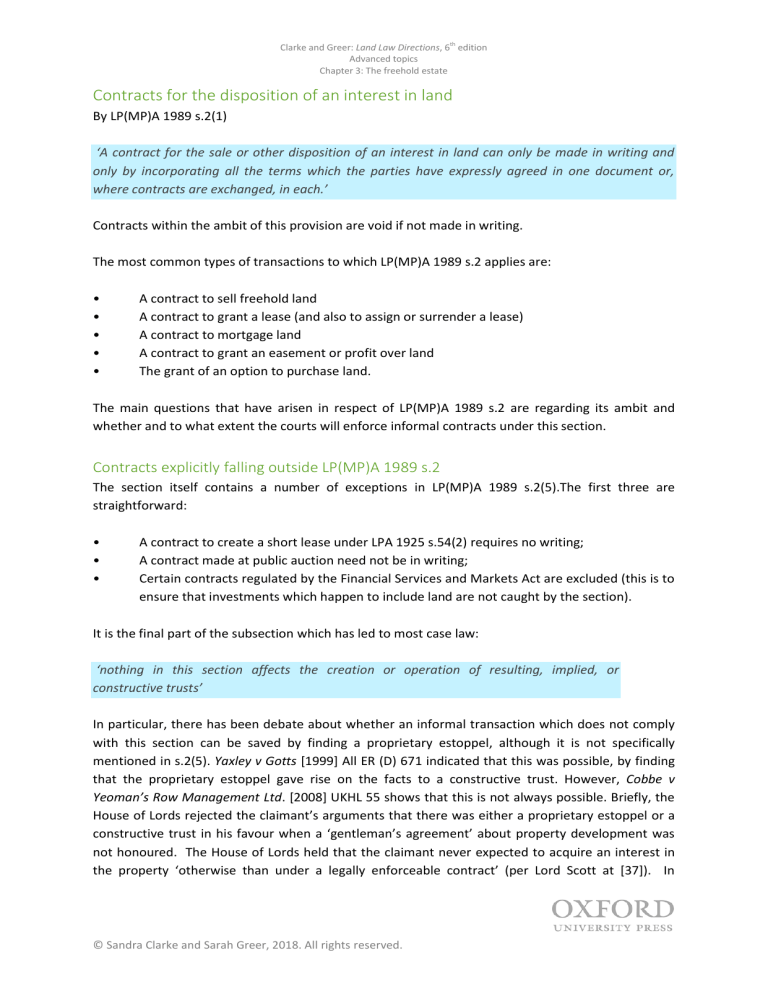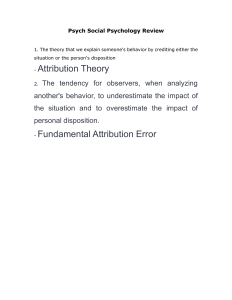
Clarke and Greer: Land Law Directions, 6th edition Advanced topics Chapter 3: The freehold estate Contracts for the disposition of an interest in land By LP(MP)A 1989 s.2(1) ‘A contract for the sale or other disposition of an interest in land can only be made in writing and only by incorporating all the terms which the parties have expressly agreed in one document or, where contracts are exchanged, in each.’ Contracts within the ambit of this provision are void if not made in writing. The most common types of transactions to which LP(MP)A 1989 s.2 applies are: • • • • • A contract to sell freehold land A contract to grant a lease (and also to assign or surrender a lease) A contract to mortgage land A contract to grant an easement or profit over land The grant of an option to purchase land. The main questions that have arisen in respect of LP(MP)A 1989 s.2 are regarding its ambit and whether and to what extent the courts will enforce informal contracts under this section. Contracts explicitly falling outside LP(MP)A 1989 s.2 The section itself contains a number of exceptions in LP(MP)A 1989 s.2(5).The first three are straightforward: • • • A contract to create a short lease under LPA 1925 s.54(2) requires no writing; A contract made at public auction need not be in writing; Certain contracts regulated by the Financial Services and Markets Act are excluded (this is to ensure that investments which happen to include land are not caught by the section). It is the final part of the subsection which has led to most case law: ‘nothing in this section affects the creation or operation of resulting, implied, or constructive trusts’ In particular, there has been debate about whether an informal transaction which does not comply with this section can be saved by finding a proprietary estoppel, although it is not specifically mentioned in s.2(5). Yaxley v Gotts [1999] All ER (D) 671 indicated that this was possible, by finding that the proprietary estoppel gave rise on the facts to a constructive trust. However, Cobbe v Yeoman’s Row Management Ltd. [2008] UKHL 55 shows that this is not always possible. Briefly, the House of Lords rejected the claimant’s arguments that there was either a proprietary estoppel or a constructive trust in his favour when a ‘gentleman’s agreement’ about property development was not honoured. The House of Lords held that the claimant never expected to acquire an interest in the property ‘otherwise than under a legally enforceable contract’ (per Lord Scott at [37]). In © Sandra Clarke and Sarah Greer, 2018. All rights reserved. Clarke and Greer: Land Law Directions, 6th edition Advanced topics Chapter 3: The freehold estate Herbert v Doyle [2010] EWCA Civ 1095 a question again arose about the enforceability of an oral agreement that had been substantially performed, but which additionally required the ‘swap’ of three parking spaces between the parties. The Court of Appeal held that the agreement was sufficiently certain and complete to give rise to a constructive trust. Similarly, in Matchmove Ltd v Dowding [2016] EWCA Civ 1233, there was an oral agreement which both parties intended to be immediately binding and which contained all the essential terms. The respondents had paid money under the agreement and relied on it to their detriment. It was held that a constructive trust had arisen and the agreement was valid. The cases indicate that the courts are not keen to bring part-performance back into the law by the back door. Only agreements which are substantially complete and not requiring further negotiation will be enforceable under this exception, which will not be interpreted widely. Documents forming part of a contract for the disposition of an interest in land Apart from the specific exceptions in s.2(5), the courts have also had to decide whether particular documents or contracts form part of ‘a contract for the sale or other disposition of an interest in land’. Particular difficulties have arisen when there is one main contractual document which contains the main terms, but a later exchange of letters between the parties. The section provides that the writing must incorporate ‘all the terms which the parties have expressly agreed in one document, or where contracts are exchanged, in each’. The essential terms for a valid contract to sell land (Rossiter v Miller (1878) 3 App Cas 1124 at 1143, 1148) are the parties, the property and the consideration. Other terms, such as the completion date, are not essential because they can be implied into the contract by law. More than one document may form the contract if one of the following three situations applies: 1. The parties have agreed to have a copy each and exchange them: this is the usual situation. Generally, two copies of the contract are drawn up, each signed by one of the parties and the copies are exchanged. 2. The second document is implied into the main document by reference to it in the main document (LP(MP)A 1989 s.2(2)): in Firstpost Homes v Johnson [1997] 1 WLR 38 a plan was incorporated by referring to it in the main body of the contract. One party signed only the plan, not the main contractual document, and this was held to be insufficient to comply with s.2. 3. The second document is held to constitute a collateral contract, which does not form part of the contract of sale. An example of this is shown in the case of Record v Bell [1991] 1 W.L.R. 853. In which a letter from the Vendor’s solicitor, offering a warranty of title whilst official copies of the register were awaited, was held to be a collateral contract outside the terms of the main contract for sale, and thus did not have to comply with LP(MP)A s.2 to be valid. Another example is that an option to purchase land in the future is a contract to sell land, and must fulfil the requirements of s.2. However, a letter exercising such an option is not required to be signed by the vendor, as it is a unilateral act, and therefore does not have to comply with LP(MP)A 1989 s.2- Spiro v Glencrown Properties Ltd [1991] Ch. 537. © Sandra Clarke and Sarah Greer, 2018. All rights reserved. Clarke and Greer: Land Law Directions, 6th edition Advanced topics Chapter 3: The freehold estate Contracts which are not for dispositions of an interest in land The Court of Appeal decision in Rollerteam Ltd. v Riley [2016] EWCA Civ 1291 [2017] Ch. 109 reconsiders which contracts are ‘for the sale or other disposition of an interest in land’, and therefore within the ambit of the section. The case concerned an agreement intended to settle a protracted family dispute which had resulted in four separate sets of legal proceedings. The parties to the agreement were the appellants, JA, and his wholly-owned company, Rollerteam Ltd, and the respondents LR and JD, his half-sisters. Pursuant to the agreement, LR executed two declarations of trust over London properties, owned by her, in favour of the appellants, JA and Rollerteam Ltd. In return, JA was to pay JD £2 million. In fact, he paid her only £300,000. JA contended that s.2(1) of the 1989 Act applied to the agreement. It was accepted by all parties that if this contention was correct, the formal requirements of the section had not been met and the agreement was void. The history of the agreement was that it had been worked out between the parties over lunch with no legal advisers present. Email correspondence followed, setting out the terms agreed. Three days later the parties met with a legal adviser, and inter alia LR executed the two trust deeds. As a result, in due course, consent orders were made in the litigation. At first instance, Mr Robert Englehart QC held in favour of the respondents, on the basis that: (a) s2(1) affects contracts for the disposition of land, but does not invalidate actual dispositions of an interest in land; and (b) on a proper analysis of what happened when the agreement was reached, part of the consideration for the contract formed on that day was the actual execution by Ms Riley of the two declarations of trust, rather than an agreement by her to execute them in the future. Previous cases, principally Helden v Strathmore Ltd [2011] EWCA Civ 542 had established two types of agreement outside the scope of s.2(1), which may be broadly categorised as firstly, contracts of disposition and secondly, settlements of boundary disputes. S.2 does not apply to dispositions of interests in land, as opposed to executory contracts for such dispositions. The simplest example of a contract for disposition of an interest in land is a lease. Whilst a lease is undoubtedly a contract, and sets out the obligations of the lessor and lessee, it is not caught by s.2(1). So, oral leases which are effective under LPA 1925 s.54(2) are valid, and are not invalidated by s.2(1) – a point made in Target Holdings Ltd v Priestley (1999) 79 P & CR 305 by Judge Hicks QC, who also pointed out that if s.2(1) applied to contracts of disposition, all conveyances, transfers and mortgages not executed by the grantee/mortgagees would be void, something clearly not intended by the legislature and which has never been argued. This reasoning was later approved by the Court of Appeal in McLaughlin v Duffill [2008] EWCA Civ 1627, [2010] Ch 1. Boundary agreements may in fact involve a transfer of land between the parties, but the purpose is to demarcate the boundary, not to effect a transfer of land. In Joyce v Rigolli [2004] EWCA Civ 79, [2004] 1 P & CR D 55, it was held by the CA that such an agreement did not fall within the scope of © Sandra Clarke and Sarah Greer, 2018. All rights reserved. Clarke and Greer: Land Law Directions, 6th edition Advanced topics Chapter 3: The freehold estate s.2(1), because for a contract to fall within the definition of being ‘for the sale or other disposition of an interest in land’, it must have been the parties’ intention to sell or dispose of land. It was argued by the respondents in Rollerteam Ltd. v Riley that it is the intention of the parties that matters (on the reasoning in Joyce v Rigolli) rather than the executory nature of the contract. This was rejected by the CA, on the basis that it cannot be reconciled with the Target v Priestley line of authority. The CA therefore upheld the first instance decision on the basis that there was never an executory contract; the execution of the two deeds of trust by LR constituted both her acceptance of JA’s offer of £2m., and the consideration moving from her for the promise. The contract included an immediate disposition of interests in land by deeds of trust, and was not a contract for the disposition of an interest in land which had to comply with s.2(1) of the 1989 Act. Therefore it was valid. Conclusion A number of contracts can therefore be shown to be outside the ambit of s.2(1) of the 1989 Act. Some of these were clearly within the contemplation of the drafters of the Act, but others have grown up in case law. The voiding effect of s.2 means that it is crucial to comply with it if it applies, so it is unfortunate that the section has always not proved easy to apply in practice. From the discussion above it can be seen that the following contracts are outside the ambit of the section: A contract to create a short lease under LPA 1925 s.54(2; A contract made at public auction; Certain contracts regulated by the Financial Services and Markets Act; Agreements which give rise to a constructive trust; Collateral contracts which do not form part of the contract for disposition; Executed dispositions of land; Boundary agreements where there is no intention to transfer land. © Sandra Clarke and Sarah Greer, 2018. All rights reserved.



